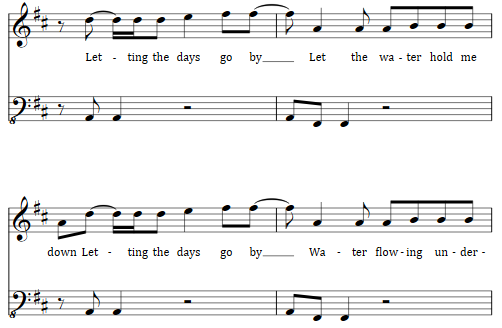For over thirty years I’ve been disturbed by the location of the downbeat in the Talking Heads song “Once in a Lifetime”. I listened to it dozens of times without paying a ton of attention to the meter, and naturally heard the verses like this:

(vocal rhythms extremely approximate) and the choruses like this:

Once I paid attention, though, I realized that there were two things kind of funny about this way of hearing it. One was that the bass line was exactly the same throughout the whole song, but was shifted by half a bar when you compared the verse and the chorus. The other was that there was a half-bar hitch both going into and coming out of the chorus.
Of course you can resolve both of these issues simultaneously by just shifting your perception of the chorus by half a measure; then the bass lines up and you don’t have to throw in any 2/4 measures:

But this really isn’t the way I want to hear the chorus! I can hear it this way if I have to, but it feels artificial, like in reality the band has shifted the beat and I’m just hearing it this way for intellectual reasons.
So how did the band hear it? Did they really hear the chorus the second way and were playing in 4/4 the whole way through, or did they hear the downbeat shift and thought that it was cool that the bass line went in and out of phase throughout the song? For decades I’ve wondered what the “correct” way to hear it is.
Until now, that is, when I read Sasha Frere-Jones’s profile of the song’s producer Brian Eno in the New Yorker. From the end of the article:
Eno’s production of this transparent, polyrhythmic light box, it turns out, is based on a mistake—his own. “That song was a very good case of people not agreeing about the one,” he told me, referring to the first beat of each measure. “I always heard it in a different place from everyone else, so I just kept sort of building things onto my one.”
Aha! So my reconstruction of the song’s evolution is:
- The song as originally conceived by the band is in 4/4 throughout with a consistent bass groove, as in the second version of the chorus above. At this point it’s probably very natural to hear it that way.
- However, Eno hears it in the other way, with the chorus displaced by two beats, and starts pushing the arrangement in a direction that emphasizes that hearing.
- We end up with a rabbit-duck situation that has been specifically engineered to be confusing, and which was based explicitly on the producer’s confusion.
In conclusion, Eno is a genius, but we already knew that.
One Comment